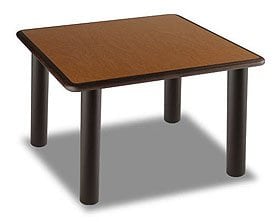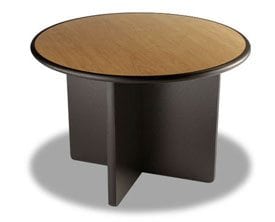Behavioral Healthcare Tables: 4 Options When Choosing Your Bases
In residential settings, tables may be seen as harmless, inanimate objects where dinner is served, homework is done and gatherings are held. Behavioral healthcare tables serve many of the same purposes. However, due to the potential mental instabilities of BHC patients, tables may also pose serious risks to all who spend time in these spaces – including staff – if furniture products that are not appropriate for the environment are installed.
One of the most important features of behavioral healthcare tables is their base. As harmless as they may seem, bases can be broken, used as a weapon or may allow for the movement of the entire table if not properly manufactured and/or secured. To ensure that BHC facilities are picking the product that is right for them, we have listed four table bases, and their features, that facilities should review before making a purchase.
Legs

Tables with legs are the most traditional choice for BHC environments due to the fact that they can be used in a variety of spaces such as dayrooms, dining areas and staffing areas. Many leg tables can be anchored to the floor and made resistant to movement or left freestanding and used for several purposes throughout the facility, providing maximum flexibility. And while table legs can come in a variety of widths, facilities should purchase tables with legs that are made of at least 10-gauge steel, but preferably 12-gauge, for maximum security and durability.
Cylinder or hourglass bases
Cylinder or hourglass bases, on the other hand, are hollow and usually made of high-impact polyethylene or other plastic material. This option allows facilities to ballast the table with weight (sand is a good option), making it difficult for patients to move the product or pick it up and use it as a weapon. However, if the facility wishes to use the table in alternate places, they aren’t so heavy that two or three staffers can’t move them without much difficulty. Cleaning staff will appreciate these options, too, since the tables can be moved with some effort so that the area around and under the base can be easily cleaned.
X-base

X-base tables have bases that are, well, designed like an “x.” This option makes tables heavier than your typical residential table due to the additional material used to create the base. This, along with the “x” design of the base, makes the tables more stable and less likely to be tipped over. And if contraband is a challenge in your facility, x-base tables – solid and constructed with no openings – force the transfer of contraband to occur around the base, making this action more visible to staff who may be monitoring this activity. Additionally, when considering x-base tables, look for those with bases that are made of high-impact particleboard and thick high-pressure laminate for maximum durability. Lastly, X-bases are also beneficial because they define personal space which can be helpful if you are managing a population sensitive to personal boundaries or prone to outbursts.
Fixed seating

Last but not least, is fixed seating. This option features seats that are mounted to the legs, which then can be bolted to the floor, creating a fusion that provides an interconnected seating and table unit with a solid, multi-leg footprint that can’t be rocked back and forth. And as mentioned before, bolted down bases prevent the table from being picked up and used as a weapon or barricade. There are a variety of these tables on the market, so when looking for your product make sure the base and legs are made of round or square tubing that is at least three inches in diameter and made of 14-gauge steel.
In Conclusion
On a side note, bases will only perform as well as the hardware used to connect them to the top. Pick bases that are connected with hardware that is screwed into embedded metal inserts on the bottom of the tabletops. This will create a steel-to-steel connection and prevent the hardware from becoming loose and the holes from being wallowed out.
Regardless of your choice in bases, ask yourself the following questions: What is most important in the facility? Do you need tables that can be moved around and used for different purposes? Our do you need tables that can be ballasted, but light enough to be moved by staff? Or in extreme cases, do you need tables that have seats mounted to legs, which are then bolted to the floor for maximum safety? Once you answer these questions, your choice in bases should be made easy.
For more information, visit Norix Furniture’s complete line of behavioral healthcare tables.